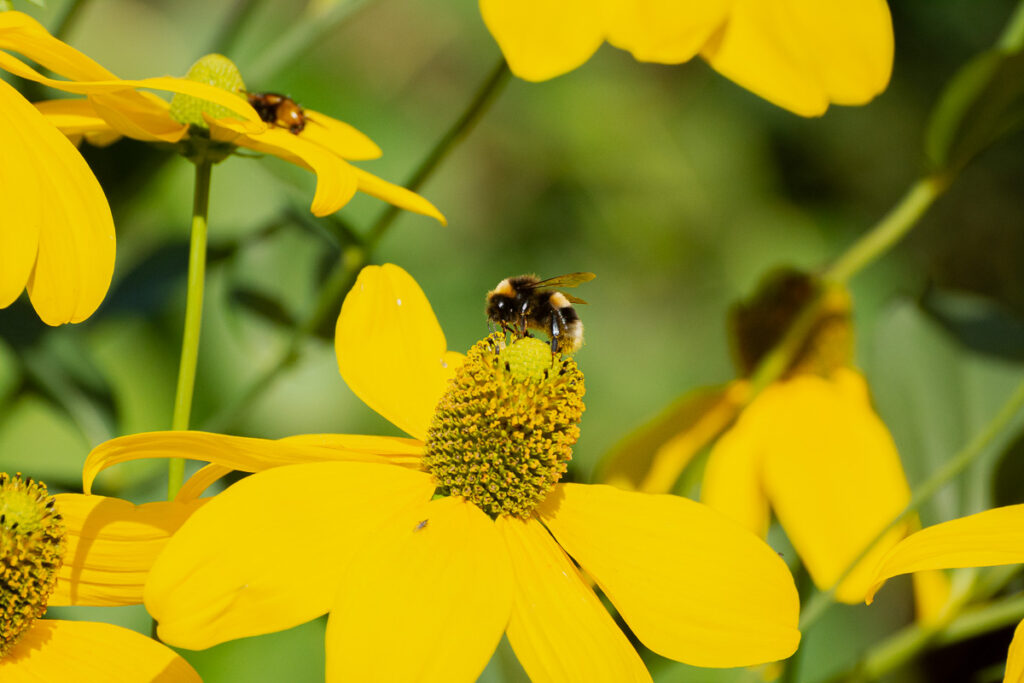
Pledge for Pollinators
Here at Blue Daisy we’re really passionate about saving our humble British bumble bee and other pollinating insects like hoverflies, moths and butterflies. The decline in our pollinating insects, especially bees, has been noticed through various studies over the last 50 years or so, the reasons are far reaching but one has been the reduction of our wild-flower meadows through the use of chemicals. Recently it has become a hot topic with many organisations including the RHS (Royal Horticultural Society) taking up the mantel led by Sarah Raven, to help gardeners identify the best plants in garden centres. They have introduced a badge called ‘Perfect for Pollinators’ which will be on plant labels in all good garden centres.
Why are we interested in pollinating insects? Well in brief, they transfer the pollen from one flower to the next allowing it to be fertilized, which means it will have the ability to set seed or produce fruits. This is really important for us all, if plants aren’t able to set seed we risk reducing the amount of plants we can have as they could become endangered or extinct. The worst case scenario is that the pollinated flowers don’t turn into fruit which means it could have a huge impact on what we are growing and eating, or not eating as the case may be! The pollination would need to be done by hand, it would be such a laborious task taking so many hours that the products themselves would subsequently be so highly priced the average person in the street may not be able to afford them.
We rely on insects to pollinate apples, raspberries, strawberries, red and blackcurrants, plums and pears so that we may eat and enjoy them. It doesn’t just stop at fruit the bean family i.e. broad beans and runner beans also the marrow and pumpkin family too are pollinated by insects. The value of insect-pollinated fruit and vegetables grown here in the UK is a staggering £220 million every year.*
What can we do? There are so many things that we as garden owners can do to help the bees, butterflies, moths and hoverflies. Did you know that the combined area of our gardens is larger than all of our nature reserves combined? It goes without saying if we change but one thing in our garden we are helping the biodiversity for our community which in turn will have a beneficial effect for our diets, also our colour and variety rich gardens. Here are just a few things you can do:
- Avoid ‘doubles’ or showy blooms because they have been bred specifically for show, there is either little or no nectar available making it so difficult for the insects to find.
- Plant insect friendly plants in a sunny spot clumped together so they can be visited without too much effort of flying a huge way to find a food source
- Don't use pesticides
- Attract moths by planting nocturnal flowering plants
- Leave a small amount of fallen fruit under a tree in the autumn as butterflies feed on the over-ripe juices.
- Leave an area in your garden to nature, let the grass and weeds grow a bit longer.
- Have clean water available as all insects need to drink, make sure there is a shallow ledge or a few stones in there so they can stand safely whilst drinking.
- Consider growing all types of plants from trees, shrubs, perennials and annuals to encourage a wider range of insects to visit your garden.
Here at Blue Daisy this year we will be encouraging our customers to consider the insects in their gardens. We will be advising which plants to buy to extend the pollinating seasons and above all we guarantee that all our planting plans will have pollinator friendly plants incorporated.
Blue Daisy is asking you to consider what you can do to help our insects, asking you to think about what new plants you are buying and making sure that at least 50% of them are pollinator friendly from now on. You don’t have to start from scratch in your garden it’s about being realistic, it’s about understanding what is in your garden now and what you can add to make it more friendly.
From now on please consider our pollinating insects every time you buy new plants for your garden or as presents for friends and relatives. Blue Daisy is a small business but if we and all of our customers, old and new, commit and if we can convince anyone else to along the way, together we will hopefully be starting a wave of change! So please, commit now yourself and use our social media buttons at the bottom of this article to get the message out to others! We really can't afford to lose our pollinators and we CAN do something about it, so please, let's try.
*Source: www.rhs.org.uk
Good Pollinator Plants
The RHS has produced a list of plants that are perfect for pollinators and here are a few of our favourite plants from that list:
Winter:
Sarcococca hookeriana (winter box)
Galanthus nivalis (single snowdrop)
Spring:
Chaenomeles x superba (Japanese quince)
Geranium phaeum (dusky cransebill)
Ribes sanquineum (flowering currant)
Summer:
Buddleja davidii (butterfly bush)
Lavender cultivars
Verbena bonariensis
Autumn:
Anemone hupehensis (Japanese anenome)
Dahlia cultivars (single flowering )




